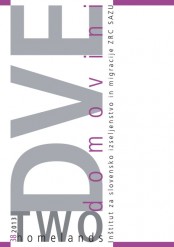Izobraževanje otrok migrantov v mednarodnem programu osnovne šole: Primerjava s slovensko osnovno šolo
Ključne besede:
mednarodna osnovna šola, slovenska osnovna šola, migracije, kakovost izobraževanjaPovzetek
V članku primerjamo nekatere vidike uspešnosti mednarodne in slovenske osnovne šole. V študijo je vključena šola iz Slovenije, ki izvaja oba programa. Med učenci iz obeh programov obstajajo statistično značilne razlike v stališčih glede kakovosti pouka, učiteljev in glede sodelovanja z vrstniki. Obe skupini učencev ugotavljata manjšo prisotnost sodelovanja z učenci iz druge skupine. V znanju učencev iz obeh programov prihaja do nekaterih opaznejših razlik, katerih statistično značilnih razlik pa ni bilo mogoče dokazati. Nekoliko podrobneje analiziramo izvajanje programa mednarodne šole. Slednji je bil pozitivno ocenjen tudi s strani staršev učencev v tem programu.
Prenosi
Literatura
Beane, James (1990). A Middle School Curriculum: From Rhetoric to Reality. Westerville: National Middle School Association.
Bernard, Michael E., Stephanou, Andrew, Urbach, Daniel (2007). The ASG Student Social and Emotional Health Report. Oakleigh Vic: Australian Scholarship Group.
Bešter, Romana (2009). Vključevanje imigrantskih otrok v izobraževalni sistem. Razprave in gradivo 59, 93–116.
Bibby, Yan, Tan, Ling (2008). ISA Technical Report. Melbourne: Australian Council for Educational Research.
Biggs, John, Kember, David, Leung, Doris Y. P. (2001). Revised Two-Factor Study Process Questionnaire R-SPQ-2F. British Journal of Educational Psychology 71, 133–149.
Cankar, Franc, Deutsch, Tomi, Setnikar-Cankar, Stanka, Barle-Lakota, Andreja (2011). Povezanost regionalnega razvoja in učnih dosežkov učencev. Pedagoška obzorja - Didactica Slovenica 26/3, 115–132.
Farley, John (2005). Majority–Minority Relations. Upper Saddle River: Pearson Prentice Hall.
Flam, Helena, King, Debra (2005). Emotions and Social Movements. London, New York: Routledge.
Fredrickson, Barbara (2009). Positivity: Groundbreaking research reveals how to embrace the hidden strength of positive emotions, overcome negativity, and thrive. New York: Crown Publishing Group.
Hare, John (2010). Towards an Understanding of Holistic Education in the Middle Years of Education. Journal of Research in Education 5, 301–322.
Heckmann, Friedrich (2008). Education and Integration of Migrants. NESSE Analytical Report 1 for EU Commission DG Education and Culture. Bamberg: European forum for migration studies.
Hill, Ian (2002). The History of International Education: An International Baccalaureate Perspective. International Education in Practice: Dimensions for National & International Schools (Eds. Mary Hayden, Jeff Thompson, George Walker). London: Kogan Page, 18–29.
IBO (2006). IB Learner Profi le Booklet. Cardiff : International Baccalaureate Organization.
Josipovič, Damir (2012). Instrumentalizacija etničnosti znotraj večnacionalnih držav: primer kolonizacije Slovencev v Avstro-Ogrskem delu nekdanje Jugoslavije. Dve domovini/Two Homelands 35, 135–148.
Kember, David, Biggs, John, Leung, Doris Y. P. (2004). Examining the Multidimensionality of Approaches to Learning Through the Development of a Revised Version of the Learning Process Questionnaire. British Journal of Educational Psychology 74, 261–279.
Klun, Maja, Setnikar Cankar, Stanka (2013). Better Regulation and Public Procurement in Slovenian Municipalities. Transylvanian Review of Administrative Sciences 38, 96–105.
Lesar, Irena, Čančar, Ivana, Jug Došler, Anita (2012). Učitelji iz Slovenije in Švedske o poučevanju (novo) priseljenih učencev. Dve domovini/Two Homelands 36, 59–72.
Luchtenberg, Sigrid (2004). Migration, Education and Change. London: Routledge.
Marshman, Roger (2010). Concurrency of Learning in the IB Diploma Programme and Middle Years Programme. Cardiff : International Baccalaureate Organization.
Mlakar, Petra (2012). Skoraj 48.000 evrov za šolanje otrok diplomatov v Sloveniji. Dnevnik (14 September 2012).
Mlekuž, Jernej (2010). Burekpomeni burekdarovanja neburekljudem. Dve domovini/Two Homelands 31, 65–77.
Musek Lešnik, Kristijan (2011). Siva knjiga o osnovni šoli v Republiki Sloveniji. Ljubljana: IPSOS.
OECD (2006). Programme for International Student Assessment (PISA). Paris: Organisation for Economic Co-operation and Development.
Perkins, David (1992). Smart Schools: Better Thinking and Learning for Every Child. New York: Free Press.
Portes, Alejandro, Rumbaut, Ruben G. (2006). Immigrant America: A Portrait. Berkeley, Los Angeles, London: University of California Press.
Schneeweis, Nicole (2011). Educational Institutions and the Integration of Migrants. Journal of Population Economics 24/4, 1281–1308.
Schofi eld, Janet (2006). Migration Background, Minority-Group Membership and Academic Achievement: AKI Research Review 5. Berlin: Wissenschaftszentrum für Socialforschung.
Stevens, Peter A. J. (2007). Researching Race/Ethnicity and Educational Inequality in English Secondary Schools. A Critical Review of the Research Literature Between 1980 and 2005. Review of Educational Research 77/2, 147–185.
Stevens, Peter A. J. (2007). Researching Race/Ethnicity and Educational Inequality in English Secondary Schools. A Critical Review of the Research Literature Between 1980 and 2005. Review of Educational Research 77/2, 147–185.
Tan, Ling, Bibby, Yan (2011). Performance Comparison Between IB School Students and Non-IB School Students on the International Schools’ Assessment (ISA) and on the Social and Emotional Wellbeing Questionnaire: Research Report. Melbourne: Australian Council for Educational Research.
TIMSS (2007). Trends in International Mathematics and Science Study. Alexandria: National Center for Education Statistics.
TIMSS (2011). Trends in International Mathematics and Science Study. Alexandria: National Center for Education Statistics.
Vrečer, Natalija, Možina, Ester, Svetina, Metka, Žalec, Natalija, Javrh, Petra, Ziherl, Teja (2008). Izobraževanje in usposabljanje migrantov v Sloveniji: poročilo raziskovalnega projekta. Ljubljana: Andragoški center Republike Slovenije.
Zimmerman, Timothy D., Stage, Elizabeth K. (2008). Teaching Science for Understanding. Powerful learning: What we know about teaching for understanding (ed. Linda Darling-Hammond). San Francisco: Jossey-Bass, 151–192.
Prenosi
Objavljeno
Kako citirati
Številka
Rubrike
Licenca

To delo je licencirano pod Creative Commons Priznanje avtorstva-Nekomercialno-Brez predelav 4.0 mednarodno licenco.
Avtorji jamčijo, da je delo njihova avtorska stvaritev, da v njem niso kršene avtorske pravice tretjih oseb ali kake druge pravice. V primeru zahtevkov tretjih oseb se avtorji zavezujejo, da bodo varovali interese založnika ter da bodo povrnili morebitno škodo.
Podrobneje v rubriki: Prispevki





